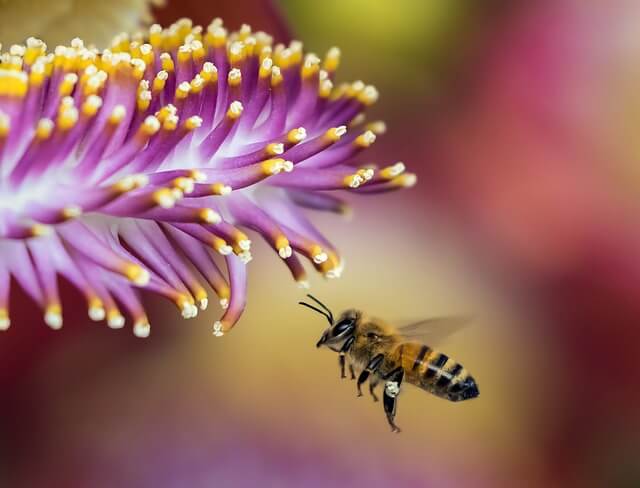Here are some general facts about bees to spur your interest in this amazing, life-giving, insect.
Interesting general facts about bees
- Bees are also known as Apis mellifera.
- Apis is a very old word, possibly of Egyptian origin, but is also related to the Greek word for herd. Mellifera means “honey” in Latin.
- Only female bees can sting, males (drones) cannot sting, but if stung it is probably a worker bee. Queen bees can sting, but due to their close proximity to the hive, queen bee stings are very rare.
- The rest of the family will know when the queen bee is removed from the hive in less than 15 minutes!
- Beekeepers have developed various methods for estimating the number of bees in a hive. In any case, a typical active bee colony may have around 50,000 workers, but may have between 20,000 and 60,000 workers.
- The male bee (drone) doesn’t have a father, but he has a grandfather!
- A bee’s uterus is about twice as large as a worker bee’s.
- A queen bee can lay up to 2000-3000 eggs per day when forming a colony.
- Bees communicate with pheromones.
- Drones (male bees) die after mating. Poor things!
- Foraging bees must fly about 55,000 miles and visit about 2 million flowers to produce a pound of nectar.
- Bees can typically fly up to 3-4 miles during their foraging trips.
- Bees fly at 15 miles per hour and beat their wings 200 times per second or 12,000 times per minute!
- The honey bee is the only insect that produces a food (honey) eaten by man in significant quantities. (There are other bees and also a wasp that makes honey, but only in small amounts).
- Honey bees use their front feet, tongue, jaw and antennae to taste with!
- The antennae on honey bees are very sensitive and important for tasting things. The tips of the antennae have more than 300 taste sensors!
- Honey bees, along with other bee species, are believed to be descendants of wasps.
- The honey bee is one of the most scientifically studied creatures in the world after man!
- Honey bees belong to the insect order ‘Hymenoptera’ which they share with other bees, wasps, ants and sawflies.
- Scent is important to bees. Bees assimilate new odors (smells) better in the morning.
- Bees eat nectar and pollen, but sometimes they eat insect secretions when food is scarce. They are also known to eat some fruits such as plums and grapes.
- The honey bee queen should certainly live 2 years, but may even live 3 or 4 years, whilst drones live for 55 days on average, and worker honey bees raised in the Spring may only live 6 or 7 weeks (those raised in the autumn may live 4 – 6 months).
- Honeycombs are hexagonal-shaped cells made of beeswax.
- The hexagon structure of honeycombs enables bees to make super efficient use of beeswax, and guards against wastage!
- The ‘Waggle Dance’ or ‘honey bee dance’ enables worker honey bees to inform her sisters about great locations of food and water, or a new home.
- Like other bees, honeybees cannot see the color red.
- Like other bee species, bees have five eyes. That is, three simple eyes in a crown and two compound eyes with numerous hexagonal faces.
- Bees have hairs in their eyes!
- Because honey bees can easily transport colonies across the country, they account for nearly 80 percent of crop pollination in the United States (although some species of solitary bees and bumblebees are increasingly being bred for pollination). Bees actively pollinate every month of the year, everywhere in North America!
- To keep warm through the winter, bees congregate in a “winter cluster”.
- Bees are often thought of as living in man-made wooden hives, but in reality, bee colonies in the wild naturally prefer to build nests in hollows such as tree hollows or caves, and often around the eves of your house or in a disused chimney.
- Bee activity, like other types of bees, depends on temperature, not season.
- Bees are most active between 60 and 100°F, but can also forage in temperatures as high as 55°F. For this reason, the California almond crop relies on bee pollination as it flowers in February before many species of wild bees come out of hibernation.

